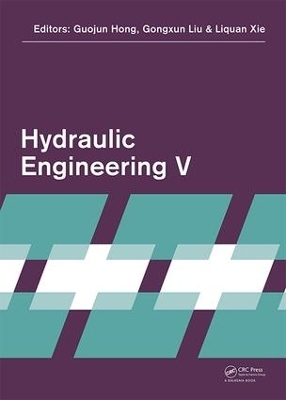
Hydraulic Engineering V
Crc Press Inc (Verlag)
978-0-8153-7471-8 (ISBN)
The selected papers mainly focus on theory and technologies related to hydraulic engineering, ecological structures in hydraulic engineering, stability and risk of hydraulic structures, estuary improvement and shoreline restoration, river engineering and sediment transport, dredging technology and equipment, flood hazards and innovative control measures, complex flow modelling, environmental hydraulics and hydrology, water purification, wastewater treatment, and geotechnical aspects in hydraulic engineering.
Hydraulic Engineering V will be of interest to academics and engineers involved in Hydraulic Engineering and Environmental Engineering.
Guojun Hong is general manager assistant of National Engineering Research Center of Dredging Technology and Equipment, and the vice-director of CCCC Dredging Lab. Mr Hong is also a technical leader in research teams about dredging equipment and technology, environmental dredging, beneficial use of dredged material, among others. Gongxun Liu works in the key laboratory of channel and dredging technology in the communication industry, mainly specializing in the researches of engineering property of soft clay, new-type marine foundation, new technology of dredging soil consolidation, soil cutting with rake tooth and reamer, mud tank model, dam construction, and the study on the engineering processing technology and equipment of mold-bagged soft clay. Gongxun is a dredging technology expert in China. Liquan Xie is an associate professor in the College of Civil Engineering at the Tongji University, Shanghai, China. He has more than 20 years of teaching, research, and industrial experience related to hydraulic engineering and geotechnical engineering. He has published more than 60 research papers and spent about 10 years teaching many courses for undergraduate and graduate students. Before teaching in Tongji University, he worked on the construction of Three Gorges Dam on the Yangtze River, the third longest river in the world. He also built up technical experience on the construction of large river-crossing bridges and highways.
1: Analyzing the influence of parameter value uncertainties on the reliability of the retaining wall; 2: A method for calculating the trajectory and extension of bow-spray for the TSHD; 3: Temperature stress analysis for a bimodulus beam placed on a double-parameter foundation; 4: Research on the law for developing cutting resistance of rake tooth during the dredging of the saturated dense silt soil; 5: A computational model for devising an intelligent densitometer for cutter suction dredgers; 6: Risk analysis of rainfall and tidal levels using maximum entropy: The secondary return period method; 7: Adapting the Afsluitdijk to climate changes; 8: Adjustment of a tridimensional network structure of ecological revetment to the local flow pattern; 9: Experimental study on the application of EIT to the measurement of concentration distribution in the dredge pipeline; 10: The flow characteristics around a hydrofoil and the stall mechanism influenced by the electromagnetic force; 11: ADAMS-MATLAB co-simulation of trailing suction hopper dredger under wave action; 12: A method of measuring the critical jet pressure of clay cutting by a moving jet; 13: Experimental and numerical investigations on the ultra-high pressure jet of a TSHD; 14: Numerical simulation of the protection engineering effect in a new development district of Hangzhou Bay in Ningbo; 15: Adjustment of the flexible mattress with ecological cavities to near-bottom flow patterns; 16: Comparison and analysis of different critical velocity models about the pipeline transport for the medium and coarse sand; 17: Coastal responses and shoreline restoration after Holocene sea-level changes in Hong Kong, China; 18: Application of the Coupled Eulerian–Lagrangian (CEL) method to the modeling of rock-breaking by a high-pressure waterjet; 19: Evaluating the effect of sulfate, alkalinity, and chloramine on iron release from iron pipes and the characteristics of iron corrosion using the response surface methodology; 20: Application of the DNDC model in simulating nitrate leaching due to irrigation and precipitation; 21: A spur-dike wetland hydrodynamic experiment with sediment discharge; 22: Physicochemical properties and carbon cycle of soil on the intertidal mud flat to the north of the Yangtze Estuary; 23: Experimental study into the blocking effectiveness of silt curtain on suspended materials; 24: Numerical simulation of high-pressure submerged waterjet cutting hard clay using the SPH method; 25: Analysis of output and power for the dredger’s cutter head under different axis angle conditions using the distinct element method; 26: Study on prestressed grid anchorage technology for slope and landslide treatment; 27: Simulation and optimization of seepage control measures for gate dam; 28: Numerical simulation of the hydrodynamic response of regulation engineering in the Deepwater Navigation Channel of the Yangtze Estuary; 29: Research on a ship bulkhead structure under the combined load; 30: Experimental study on the hydrodynamic characteristics of a geomembrane-enveloped concrete structure of ecological revetment; 31: Numerical strategy for predicting erosion in a dredging pump impeller; 32: Numerical simulations of flow past a submerged vertical cylinder with porous structure; 33: Effects of land forming on hydrodynamics in the Yangtze Estuary; 34: Response of salinity intrusion to winds in the Yangtze Estuary; 35: Reliability analysis of a slope-type seawall armor structure; 36: Wave run-up influenced by the protective facings of the sloping breakwater; 37: Comparative experiment of the influence of PVD and EVD on vacuum preloading effects; 38: Study on the wind-induced vibration of steel bridge members in a mountainous city; 39: Research on the social impact assessment index system of dam failure risk; 40: Experimental measurement of diffusion coefficients under wave action by the tracer method
| Erscheinungsdatum | 06.01.2018 |
|---|---|
| Verlagsort | Bosa Roca |
| Sprache | englisch |
| Maße | 174 x 246 mm |
| Gewicht | 453 g |
| Themenwelt | Technik ► Bauwesen |
| ISBN-10 | 0-8153-7471-2 / 0815374712 |
| ISBN-13 | 978-0-8153-7471-8 / 9780815374718 |
| Zustand | Neuware |
| Haben Sie eine Frage zum Produkt? |
aus dem Bereich


